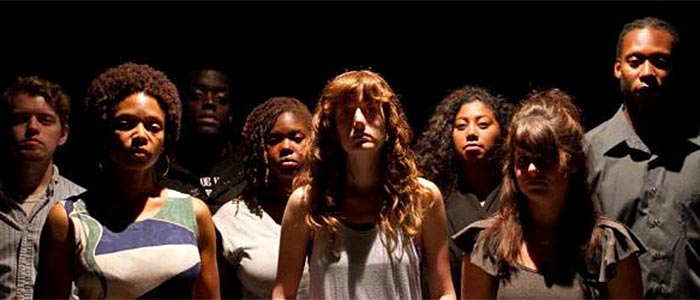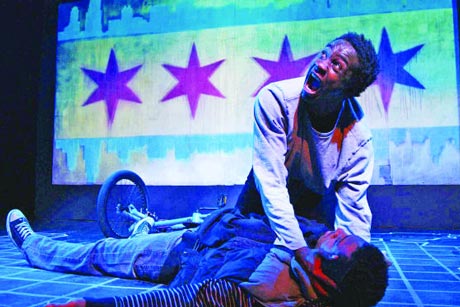Crime Scene: A Chicago Anthology is presented by Collaboraction and will be playing at the Flat Iron Arts Building (1579 N. Milwaukee Avenue) until April 7th.
If you’re even remotely up to date on current events, then you are probably well aware of the violence that the people of Chicago encounter every day. بينجو لعبة In spite of (or perhaps due to) the sheer magnitude of the city’s ‘violence problem’, instances of tragedy are frighteningly easy to sweep under the rug or to pathologize as an inevitability instead of as devastation. A recent theatrical experience, Crime Scene: A Chicago Anthology aims to bring seemingly disparate details, rhetoric and histories all under one collective narrative in order to embark upon serious discussion on alleviating Chicago’s violence pandemic through expression, listening and activism.
Crime Scene is presented by the multimedia theatre company Collaboraction, and was conceived and directed by Anthony Moseley, who serves as the company’s Founding Executive and Artistic Director. Bringing its audience back to the scene of three crimes, this play tells stories of individual victims and their families and communities, while also presenting discussions surrounding victims and crimes as well as some historical and social contextualization. Throughout the course of the play, ensemble cast members play a number of characters and take on a number of perspectives and representations. These roles are appropriately performed on various parts of the stage, often simultaneously, mimicking the juxtapositions, shared spaces and separations of people in the city and exemplifying the staggered non-linearity of urban life and the far reach of violence.

Before the piece even begins, Chicago is established as the setting – the crime scene – through a conceptual reconstruction of the theatre as the city: demographic statistics are projected onto a wall along with a morose version of the city flag. The audience mingles while standing on a gridded map of the city because there is yellow police tape impeding them from taking their seats that surround the stage area. The play, which is organized into chapters, begins abruptly in the Preface section aptly named “Thoughts from the City”, with spotlighted actors amongst the crowd shouting all kinds of explanations, justifications and declarations regarding neighborhood violence. From victim-blamers and cynics to solution-makers and the grieving community members, many of the voices are ones we have heard before.
However, the most affecting scenes in Crime Scenes are, well, the crime scenes. It is through the dramatic re-interpretations of horrific murders and assaults at the time and places they occurred where the audience finds itself observing – almost in conversation with – the victims in the moments before they are attacked. These crime scenes appear in three chapters: Chapter 2 is about the murder of 12 year-old Orlando Patterson, Chapter 6 is about the gunning down of young rapper Lil Jojo, and Chapter 8 is about the beating of exchange student and her friend Natasha McShane and Stacy Jurich. In the first we see the plans and coercions of perpetrators and police questioning, in the second we listen to the words of a young boy on his bike about his life as he sees it until we hear the sound of a gun shooting him and in the third we see what two victims and two attackers may have been talking about before a brutal assault. There are overlapping qualities to these crimes (shock, tragedy, youth, first person narratives, crime rhetoric), but they all differ in motive and nature. كيف ربح المال Each is striking, and it is in the details where much is said about the nature of crime both in Chicago specifically and potentially everywhere. لعب بينجو

The three crimes are contextualized with social, racial and class histories in Chicago, which are briefly outlined in chapters like “A Timeline of Chicago Violence” and “Thoughts from the Front Line.” Real words from newscasters and online remarks are also included in creations of certain scenes, showing the pervasiveness of discussions about violence in every medium of our daily lives.
Through being reminded of these murders and having them performed in front out us, the audience has no choice but to face them and become involved in the conversations that surround them. You can’t help but have a thought, an opinion, a conviction, or even a direct experience related to what is being performed in front of you. In an era when it seems increasingly difficult for a person to conjure real empathy for individual victims of murder and brutality or sufferers of systemic devastation, this play wants to “let hope rise.” This is an outlook expressed in the original song of that very name written by ensemble member Victoria Blade. Crime Scene conjures the inherent tribal loyalty and compassion that may make us want to cry along with a grieving family member or even be called to action.
Taken as a whole, Crime Scene is a cry for response and community collaboration. When you couple the piece’s topics with the post-show discussions, it is clear that the creators are pushing the point that art and expression are of paramount importance in activism and inciting people to change themselves and their communities. The piece was devised not only by professionals working in theatre, but also by people from Chicago advocating for Chicago neighborhoods. Those involved do not wish for the play to exist in and of itself – they wish to present “outreach performances” to audiences and in settings all around Chicago, including local people in the discussion and even the production through interviews with residents and presentations of the piece in public places where there are also plans to build theatres that will “remain as a community asset and lasting imprint long after the show is over.”
Where Crime Scene goes in the future will define it as a living anthology and not just a play. Like a literary anthology, it can always be updated, added to, altered, learned from and with, and bring a number of ideas, people and stories under one cover. In this case, the creators of the piece will have to connect itself directly with Chicago’s people and places. These personal stories are important to tell and keep telling because they are indicators that we need to do something about the violence and hurt our people face on a daily basis – in Chicago, in cities and towns all over the US and beyond. It’s political, it’s social, it’s emotional, it’s absolutely crucial. There are many ways to tell these stories, whether they be through responsible journalism, thoughtful intellectual critique, poetry, music, visual art or more, and the particular structure of Crime Scene: A Chicago Anthology allows for more installations and the inclusion of a variety of performative formats and topics – and there are, sadly, many more topics to choose from…just off the top of my head: police brutality; sexual assault in homes, on the streets and in prisons; political disenfranchisement; economic and educational inequality…
Crime Scene: A Chicago Anthology is definitely onto something here. I would like to see more collaborative ‘anthologies’ be created, where interviews, research and history can be united with real events, real people, artistic expression and activism in an open and localized manner.
Crime Scene: A Chicago Anthology has been extended for four weeks and will now be running through April 7th, four nights a week. Tickets can be purchased at this website or by calling 312.226.9633. The show is recommended for ages 15 and up due to violence and mature content. If you can’t make it out to see Crime Scene, you can also make a donation to fund future productions of the play here.